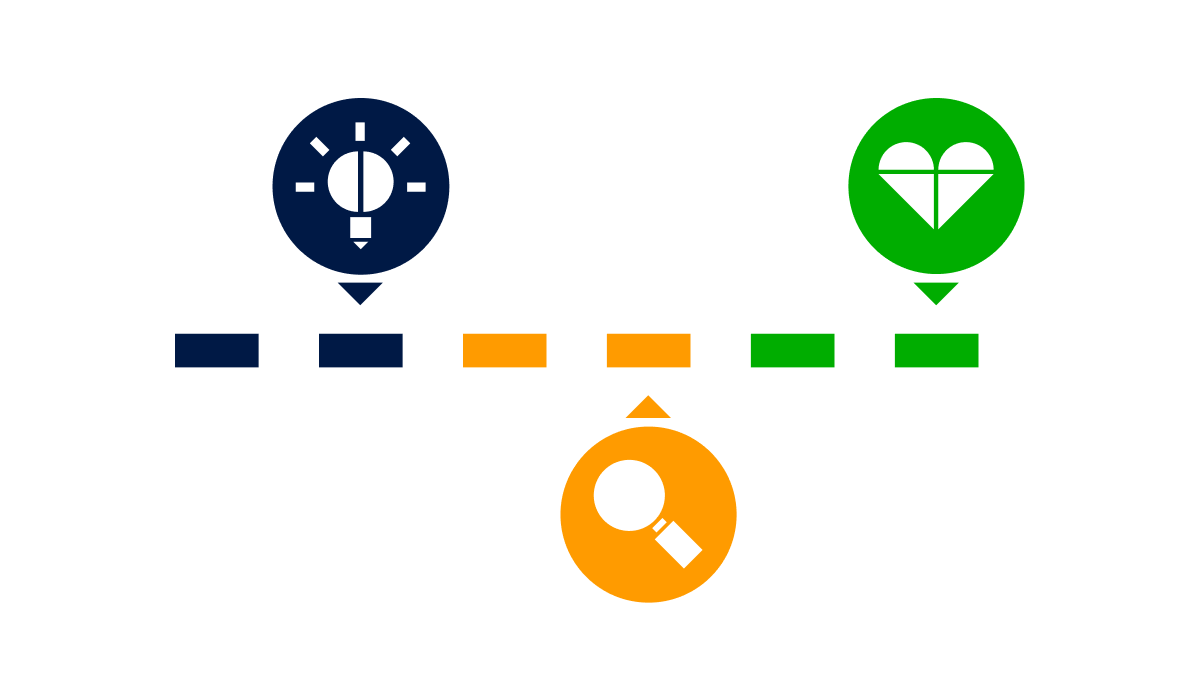Creating content for your B2B marketing funnel stages can seem daunting, but that content is essential in helping your sales teams close deals.
Creating a plan for such a funnel is building the roadmap to your success. And what kind of marketer wouldn't want that?
What is a B2B marketing funnel?
Even if you don't think you're using a marketing funnel—you probably are. Each of your marketing and sales practices sits somewhere in the sales funnel: whether introducing promising prospects to your brand, suggesting solutions to their problems, or knowing exactly how to answer their questions via email, chat, or social media.
When you know precisely how they work, a mapped-out b2b marketing funnel will help you decide which platforms, tools, and content formats are ideal for each stage while helping you spot the gaps that need filling.
Discover: 19 types of marketing collateral you need now.
When marketing to a single consumer, a B2C funnel tends to be much less complicated. Selling a single product to a single user requires fewer resources than selling a brand's solutions to an organization where decision-makers are rarely the product users.
It means more effort and resources, smarter strategies, and continuous monitoring and measuring to optimize those operations.
A B2B content marketing funnel works across several stages, often considered top, middle, and bottom.
Today, we're considering the following levels as we look at how to build a B2B marketing funnel.
- Awareness - Planting a seed with your customers / hopeful leads are introduced to your brand.
- Consideration - feed your seeds to see them grow / you shower those introductions with information and solutions to problems.
- Evaluation - your new seedlings are growing into healthy plants / they engage with trials or promotions, nibbling on your hook.
- Action - it's time to pick the fruit of your efforts / your sales team takes over to clinch the deal.
- Re-engagement - encouraging further growth and far more fruit / whether they bought your product at the first strike, continuing to pursue healthy leads will convert first-time sales and re-orders.
More on the marketing funnel stages here.
Where to start? Setting up your B2B marketing funnel
Before you build your sales funnel and its content, you need some good old-fashioned data to build up the basics.
Using your existing analytics, sales, and CRM software, you need to decide precisely who your ideal customer is, the one that's most likely to convert and spend the most, where they hang out, what lures them in, and the problems they love you to solve for them. Consider how your CRM software directly integrates with your content so that you can analyse engagement at each stage of the funnel.
That information dictates the ideal content and strategy for each stage and the platforms you'll use to deliver the information.
So, is there a particular role, industry, or area where you sell the most? Which are your best-performing advertising models? And what are the recurring demographics of your biggest spending customers?
And it's not just your data you should consider; there are all of your competitors' successes to take on board too. Check out who they're posting to, what they're posting, and who's reacting to it. Competitor analysis can show you the things you haven't thought of, the gaps in your process, and all the things you could be doing better.
1. Awareness stage
Awareness is all about your brand. It's your introduction to your hopeful new leads, and it could come from a range of touchpoints, from ads, web searches, white papers, social media, word of mouth, or a sales email. Ideally, your content at this stage is designed to show those leads how professional you are, that you fit their ideal supplier model, and that you can resolve the operational problems they face.
You need to be the authority they're looking for—the answer to their problems. You don't need them to commit to anything yet; you just need them to want to know more about you.
Best channels for awareness
- SEO
- Press releases
- Paid search (non-branded)
- Paid media (social media, display ads)
- Native advertising
How should you measure the success of awareness campaigns?
You'll know if your awareness campaigns are working by the uptake in engagement you receive. By generating this increase in interest, you should see more web traffic, social media connections, and inquiries.
Discover: Top lead generation KPI's you need to measure.
2. Consideration stage
Once you've got them in through the top of your funnel, prospective leads fall into the consideration phase—wondering whether your product and service are better than your competitors.
It's up to you to tell them why you're their best choice. However, if they’re engaging with you, use that to connect with them, providing them with more detailed information and solutions specific to their inquiries or comments.
Alternatively, if they've fallen into your funnel without providing a means of contact, this is the time to nurture one. Consider any way of achieving an email address: gated content, free trials, contests, giveaways, or even free consultations.
Best acquisition channels for consideration
- Paid media — Retargeting with display ads on social platforms such as LinkedIn, Facebook, and Instagram, with a clear value proposition, e.g., free consultations, analysis, demos, trials, etc.
- Social media conversations and outreach.
- Branded search.
- Affiliate marketing.
- Paid search — Targeting high-intent keywords relevant to your product and service.
- Online webinars and product showcases.
- Landing pages — Optimize landing pages with A/B testing using analytics and heatmap programs such as Hotjar.
How should you measure the success of consideration campaigns?
You should measure the campaigns you deliver at the consideration stage on a cost-per-lead basis. Moving further down the funnel, your b2b marketing metrics should be easier to analyze and measure. Achieving your highest ROI means delivering the lowest-cost highest-delivery options.
3. Evaluation stage
The evaluation phase of the marketing funnel represents the vital handover from marketing to sales staff, demanding outreach and content designed to nurture qualified prospects into conversions.
Your contact methods and material should be appropriately personalized to those hot leads, offering them what you know should get them over the finish line.
It's time for those free trials to go to work and your promotions to look even more enticing.
Best channels for evaluation
- Email marketing
- Phone calls
- Paid search
- Retargeting — Reinforce your product attributes by sending your customer base's success stories and case studies to contacts in your CRM across online channels.
How should you measure the success of evaluation campaigns?
You're looking for an increase in or a healthy number of leads who’ve taken the next big step—downloading trial software, attending demos, or engaging with your sales team via email, a call, or a meeting.
The evaluation stage offers valuable information about how your leads got this far. Setting up a feedback loop to analyze and optimize targeting methods, channels, and contact is essential to narrow down your highest-quality leads and best performers.
4. Action stage
By now, your leads should be converting into customers. Great news—your work here is done! But is it? Not a chance. The action stage offers an opportunity to provide exceptional service and UX to your new customers, upselling and cross-selling as you go.
Educating new customers is the best way to help them get the most out of their new purchase and also the best way for you to retain them, ensuring repeat sales. You already know how much easier and more cost-effective retaining customers is than acquiring new ones. So keep them updated and upgraded, show them new techniques and special offers, and keep nurturing them until they can't imagine a life without you.
Learn more about nurturing your audience with great content here.
Best channels for action
- Email marketing
- Phone calls
- In-app pop-ups
- Customer satisfaction/product feedback surveys
- Social media (organic)
How should you measure the success of action campaigns?
Your success here is measured by your customer spending. The other key areas to monitor are your contract renewals and churn; they'll highlight how well you retain or lose customers.
Customer satisfaction surveys will give you direct information into why either of these outcomes could be happening, especially if the numbers are heavily weighted in a direction that isn't what you want to see.
Monitoring sales cycles—period to period—can also uncover positives and negatives in your processes, depicting flaws and strengths in your sales team's follow-up strategies.
5. Re-engagement stage
There's never a good time to relax in marketing, so stage 5 of your funnel involves going back to any leads that showed positive interest but never committed—for whatever reason. Perhaps they merely need another nudge, and now’s a better time? Re-engaging with automated 'special offers' or 'extended trials' emails are often just enough to get them back on the hook.
You know these leads are interested. What you need to work on is what it takes to get them over the finish line.
Best channels for re-engagement
- Email marketing
- Phone calls
- Social media (organic)
How should you measure the success of re-engagement campaigns?
If leads are still opening your emails, they're still interested in your product, and there's still a chance of a sale. Keep an eye on offers and free trial conversions for what's working best with your re-engagement leads; utilize those tools as your star performers.
Discover: Unlike static forms of content see how Foleon's content creation platform lets you track user engagement across the entire b2b marketing journey.
Final thoughts
Understanding what makes your ideal sales funnel for B2B marketing helps you to build strategies that will continue to convert (with a bit of regular analysis and optimization, of course).
As we know, data is king, and testing is a must, so tracking and feedback of your content and strategies are essential—from your customers, your teams, and all the software you've got in place.
They all deliver the valuable information and driving data that we, as objective and systematic marketers, are hungry for, data that makes up the continually delivering funnel practices we need to meet our dream targets over and over.



